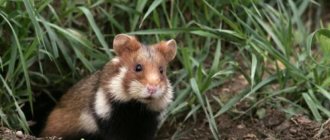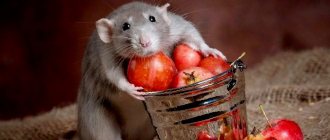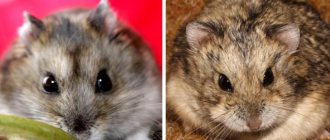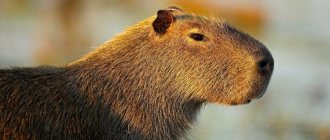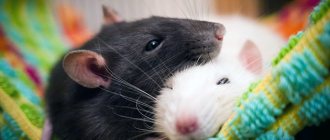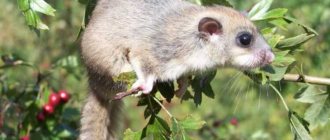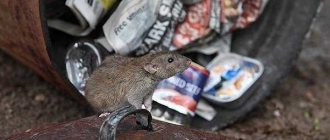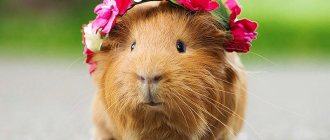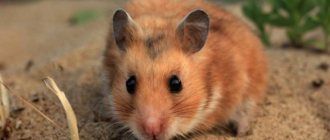European civilization has been familiar with the black rat for much longer than with the gray rat (another name for which is pasyuk). When pasyuks first began to conquer Europe in the Middle Ages, black rats were already the scourge of agriculture and big cities. It was black rats that ancient authors mentioned in their works, that is, the civilized world has known these rodents for several millennia.
Today, after just a few centuries, both in Europe and Russia, the black rat is found less frequently and in smaller quantities than the gray rat. Here, many people may never see representatives of this species in their entire lives, although they huddle next to them in residential buildings, in enterprises and near housing, but in much smaller quantities than Pasyuks.
Below in the photo is a black rat:
And here is a gray rat, or pasyuk:
And if today the pasyuk is, one might say, the main rodent pest in everyday life and in agriculture in Europe, Russia and North America, then black rats are not so noticeable here, and the scale of their wrecking is much smaller. It seems as if the gray brothers are shamelessly pushing the blacks out of nourishing and comfortable lands, leaving them only with what they themselves neglected.
How did it happen that in just a few centuries (not such a long period by evolutionary standards) black rats turned from the main enemy of the national economy in Europe into a pale shadow of their gray brother? And are they really complete outsiders in the merciless competition with the bosses? Maybe their defeat is only apparent?
The answers to these questions lie in the peculiarities of the biology of the species, which let’s talk about in more detail...
Appearance
In appearance, the rodent of the mouse family is somewhat smaller than its relative, the gray pasyuk:
- body length does not exceed 22 cm;
- the tail is always longer - about 28 cm;
- body weight from 130 g to 300 g;
- the ears are small, but wide at the base, round, more like a mouse’s;
- the muzzle is elongated, round eyes are clearly visible.
The coat consists of an undercoat and long, hard outer hairs. The color is black with a greenish tint, but it can also be dark gray, like Pasyuk. On the sides the coat is always lighter – dirty gray in color. The tail is long, scaly, and completely covered with long black hairs. There is a small brush at the tip.
The color of the black rat differs depending on the region where it lives. Southern representatives are always lighter. Northern rats are black with a brilliant green tint.
Interesting!
The description of a black rat is always compared to a pasyuk. These are the main competitors who do not get along well in the same territory. Gray relatives are superior in numbers, size, predatory habits, and ability to quickly adapt. But black rats are more resistant to poisons.
A photo of a black rat is presented below; you can clearly see the animal in all its glory.
Black rat
What does it look like
The black rat is small in size. The length of her body does not exceed 22 centimeters, and her weight ranges from 130 to 400 grams. The pest's tail is longer than the body and grows up to 29 cm. It is thickly covered with hard hair. The color is the same on both top and bottom.
Interesting!
This type of rat is the smallest and most agile.
The rodent's muzzle is elongated with black eyes. The ears are round, larger in size than those of the Pasyuk, but smaller than those of a mouse. They are thin, pink in color and lightly covered with fur.
There are two types of black rat color:
- Dark, close to black. Guard hairs with a metallic sheen. The abdomen is ashen or gray.
- The color is like the Pasyuk's, but a little lighter. The belly is white or light yellow.
The animal's legs are short. The hind limbs are larger than the forelimbs. The fingers are tenacious and have sharp claws. Thanks to them, the rat masterfully moves on any surface.
Photos of the black rat demonstrate how very different it is from the Pasyuk.
Black rat
Location
Where the black rat lives is a very interesting question. The favorite habitat for the rodent is sea vessels. Rats live side by side with humans and eat identical food. They spread around the globe thanks to water transport.
The black rat is less inventive than its relative the Pasyuk. Content with little. Settles near reservoirs and rivers. But it is less attached to water than the gray one. Does not build nests in the ground, avoids water, but if necessary, swims quite a long distance. It does not dive because fish, fry, and amphibians are of little interest to it.
Willingly settles in the forest, fields, and edges. The lifestyle is more reminiscent of voles. In urban areas, it prefers sewers, abandoned buildings, garages, garbage cans, and entrances. Can live in a person’s house, occupying the upper floors or attic.
Where do the animals come from?
Fossil remains discovered by archaeologists indicate that the original habitats of black rodents were the Mediterranean and Middle Eastern territories. The animals managed to spread throughout the world thanks to their “love” for sea travel - they penetrated into remote territories from ships. In ancient times, black rodents were already found on almost all continents of the globe. The exploration of Russian lands by dark animals dates back to the beginning of the 17th century.
Lifestyle
Habitat of the black rat
The black rat builds nests in old hollows and trees. For construction he uses twigs, sticks, and moss. The rodent's house looks more like a magpie's nest. Often rodents simply occupy a ready-made nest, eating the legal inhabitants.
Black rats spend the day in the nest, hiding from the sun's rays. They intensify their activity after dark. They behave carefully. Because there are plenty of natural enemies - dogs, cats, hedgehogs, birds, wolves, foxes.
The black rat part can be seen on the tree. The rodent climbs well on horizontal and vertical surfaces. If necessary, climbs to the very top.
On a note!
In the old days they lived in a man's house under a thatched roof. Modern rodents prefer attics. They share territory with pasyuki. The first live above, the second below under the floor.
The average lifespan of an animal in the wild is 1 year. As a pet it lives up to 4 years.
Duration and lifestyle
Black animals that live in freedom love to build houses in the form of nests in trees. It happens that they occupy a ready-made dwelling, and its inhabitants are first destroyed. Animals are excellent tree climbers and can easily climb vertical trunks, but they do this extremely rarely.
Wild rodents do not like sunlight; daylight is a time of rest for them. Animals are very careful, because at any moment they can become prey to predators. The instinct of anxiety is also transmitted to domestic rats. Animals are always on the alert, they cannot be taken by surprise.
In wild communities of black rats there is always a leader (male) and 4-6 assistants (females). If animals are brought to cool latitudes, they stop reproducing until it gets warmer. It is for this reason that gray pasyuki are replacing black rats, despite the similarities in appearance of both species.
Domestic rodents remain social animals. Experts advise, if possible, to purchase them in groups, which consist of individuals of the same age of the same sex. This helps to avoid rapid reproduction of pets, as well as conflicts between them.
Domestic rats are very clean. They are easy to care for, but you will need to purchase:
- cell;
- filler;
- feed.
Timely cleaning of the animal's home eliminates the possibility of unpleasant odors. The rat independently chooses the place in the cage where the toilet will be. There you need to place a small tray with filler. In the wild, black rats rarely live beyond 2 years. Pets with good care can live 3.5–4 years.
Interesting! If the little rats at first vigorously “sort things out,” you shouldn’t be surprised. When a natural hierarchy is established, the animals will calm down, live as a family and play together.
Nutrition
The black rat can hardly be called a predator. The rodent prefers plant foods, plant seeds, grains, vegetables, and fruits. Protein foods make up a small part of the diet. Occasionally eats beetles, worms, and may covet bird eggs.
Interesting!
A rodent eats 15 g of food and 15 ml of water per day. Hunger is difficult to bear. In the absence of food, it can live no more than 2 weeks. If there is a shortage of water, it dies within a week.
Baby rats
Gnaws everything in sight
And the trouble is not only in our heroine’s good appetite. The rat needs to grind its teeth all the time - after all, its incisors are constantly growing at a speed of up to 2-3 mm per week
And God forbid if they get their teeth into something super important!
Once in Japan, a rat stopped 16 trains on the Tokyo-Osaka line. The investigation into the case showed that the scoundrel chewed through the alarm cable and turned off the traffic lights.
In the house of an altapress.ru friend, a rat named Krysya chewed the phone buttons, the Mac keyboard and got to the computer mouse. The battle between the rat and the mouse ended with the acquisition of new and expensive peripheral devices, and the hooligan was briefly placed in an isolation ward - a cage.
Isolating it is the only way out, because it is hardly possible to hide anything from this creature. She easily jumps to a height of up to a meter, makes her way between vertical surfaces to the target, and moves through pipes. And at the same time, he easily remembers the most winding path, feeling comfortable in city communications.
Rat.
visualhunt.com
Reproduction
Black rats are not as fertile as their pasyuki relatives. During the year, the female gives no more than 5 offspring under constant living conditions. In the wild, only 3 offspring are produced. With the onset of the cold season, sexual activity decreases.
There are from 3 to 11 cubs in one litter. In contrast to gray pasyuks, cannibalism is less developed. Females rarely eat the young, but protect the nest from the male. The animal enters into sexual contact with several males at once. Pregnancy lasts about 28 days.
Enemies
The animal is not a predator. He is hunted by other animals: owls, cats, snakes. Pasyuki also influence the decrease in the population of black rats. Owners of private houses specially get a cat so that it can help fight pests.
Interesting!
In villages, there is often a queue for the litter of kittens from the rat trap. A cat teaches kids how to hunt rodents.
People use not only the services of cats. Terriers are a breed of dog bred to hunt and kill rats.
Baby black rats
They are born naked, blind, deaf, with undeveloped limbs. But they have an excellent appetite, and significant physical transformations occur every day:
- within a week they become overgrown with fluff;
- after two - hearing appears, eyes open;
- within three weeks, the formation of the limbs and skeleton is completed, and the pups crawl out of the nest.
After a month, the cubs of black rats become independent, eating food typical for adults. They are expelled from the nest, but continue to live in the same colony. The female becomes sexually mature at 6 months.
Rodent abilities
Pasyuk's life
The gray rat is called the intellectual of the animal world. Their brain, in relation to body proportions, is similar to the structure of the human body. And the number of chromosomes in genes is 2 more than in humans
Thanks to this feature, gray rats behave extremely cautiously, perform complex maneuvers when moving, and avoid traps and traps for rats.
Cellar rats are nocturnal, but in constant twilight they are active around the clock. Animals are afraid of bright light because their eyesight is weak. There are blue and green colors, the rest are perceived as black.
To see the overall picture, the animal swings its head from side to side. In this way, it determines the distance to objects and calculates the optimal route. In familiar areas, it constantly moves along a studied trajectory. Moves along walls, baseboards, and pipes.
Harm to humans
Black and gray rats are equally dangerous to humans. Rodents spread terrible diseases, carry pathogens, worm eggs, and fleas. In the previous century, the black rat was the main carrier of plague.
They spoil and destroy food supplies. They get into warehouses, barns, storage rooms, cellars. In the spring, an invasion of black rats is dangerous due to gnawing on the bark of young trees and the death of plants. In the fall, the harvest is spoiled.
In the house, pests gnaw on walls, furniture, decorative items, and wall insulation. Rodents even grind what is of no nutritional value to them in order to stop the growth of teeth.
Spreading
Previously, the black rat lived only in North Africa and the subtropical zones of Eurasia. With the help of humans, the rodent has spread throughout the world. Now the habitat of the animal is shrinking. But in regions with a warm climate, the animal continues to actively reproduce.
The spread of the pest occurs in the following ways:
- Through goods transported by people by land, water and air.
- Independently along roads and railways.
Tiny paws run several kilometers a day. The rat quickly finds a comfortable place to live and acquires a flock.
Fighting methods
Relocation closer to a person’s home occurs when unfavorable conditions occur - lack of food, premature cold snap, forest fires.
- In gardens, trees are tied with belts to prevent rats, and glue or resin is applied.
- For destruction, traps and traps are placed on the summer cottage.
- Chemicals are used on the territory of the house - poisonous baits, powders, dusts, and traps are built.
- If the premises are severely infested, specialists are called in.
Black rats are not characterized by seasonal population fluctuations. There are no widespread outbreaks of infection observed. It is advisable to use repellent methods to control pests. They use herbs, substances with a pungent odor, and repellent devices.
Habitat
Black rat: resident of the city and field.
Rats of this species are found in Europe, Asia, Africa, America and Australia. In Asia, where a temperate climate prevails, black rats are rare, since this area is the natural habitat of the gray rat.
But the climate of Australia turned out to be especially favorable for the black rat, while the pasyuk did not take root in this area.
On the territory of Russia, the black rat is found in the European part of the country from Arkhangelsk to the Caucasus. The rodent lives:
- in the Far East;
- Sakhalin;
- Kamchatka;
- Shikotana;
- Commander Islands;
- in Ussuriysk;
- Komsomolsk-on-Amur;
- Khabarovsk;
- Blagoveshchensk.
You can meet the gray rat Pasyuk, with whom the main character is so often compared, here.
